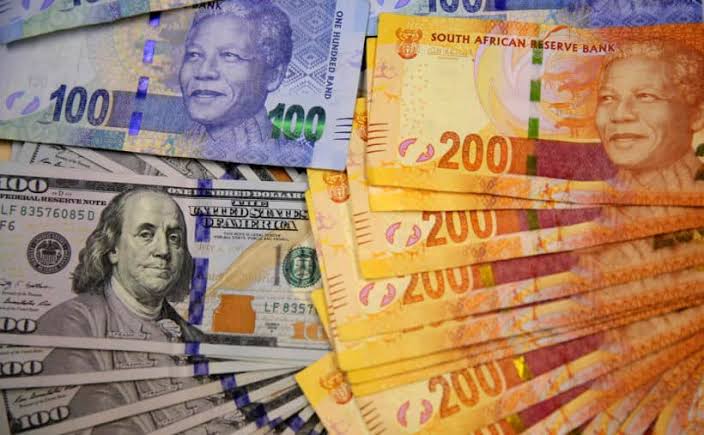
South African rand regains some ground against the US Dollar
The South African rand firmed in early trade on Monday, recovering from an all-time low hit against the dollar last week as investors were spooked by possible sanctions amid U.S. allegations. SOUTH AFRICAN RAND REGAINS SOME GROUND At 0750 GMT, the rand traded at 19.050 against the dollar, 1.45% stronger than its previous close. The […]

The South African rand firmed in early trade on Monday, recovering from an all-time low hit against the dollar last week as investors were spooked by possible sanctions amid U.S. allegations.
SOUTH AFRICAN RAND REGAINS SOME GROUND
At 0750 GMT, the rand traded at 19.050 against the dollar, 1.45% stronger than its previous close. The currency – already under pressure over the worst power cuts on record – was pummelled last week by investor concerns over a U.S. allegation that a Russian ship had picked up weapons in South Africa in December. It hit 19.51 to the dollar at one point on Friday, its weakest level ever. South African officials swiftly rejected the U.S. claims and said it had not approved any arms shipment to Russia in December.
ALSO READ: Millions of young South Africans are jobless: Soft skills
On the stock market, the Top-40 and the broader all-share index were both up nearly 0.1% in early trade. South Africa’s benchmark 2030 government bond was stronger in early deals, with the yield down 20 basis points at 10.740%. The country’s international bonds also rose more than 1.5 cents in the dollar, with longer-dated maturities chalking up the biggest gains after setting six-month lows last week. The 2052 bond was up 1.475 cents to 83.507 cents in the dollar at 0749 GMT.
US DOLLAR
Reuters: The U.S. dollar remained under pressure on Tuesday, weighed down by the risk of a U.S. default as a standoff between Democrats and Republicans over raising the debt ceiling showed few signs of being resolved. The Aussie dollar flipped from early small gains to a loss after economic data from key trading partner China fell short of analysts’ forecasts, adding to evidence of a sputtering COVID recovery. The U.S. dollar index – which measures the currency against a basket of six major peers – was little changed at 102.46, after sliding 0.26% overnight and retreating from a five-week high. The dollar had been buoyed last week by both safe-haven demand amid weak Chinese economic data and by a surprise jump in U.S. consumer inflation expectations, putting the risk of a June Federal Reserve rate rise back in play. This week, though, the looming borrowing limit – which Treasury Secretary Janet Yellen reiterated could be hit as soon as June 1 – has forced its way to the front of investor minds.
ALSO READ: Top 3 richest South Africans in the world – 16 May 2023
President Joe Biden expressed confidence a deal could be done in time ahead of an expected meeting with congressional leaders later on Tuesday. However, Republican House of Representatives Speaker Kevin McCarthy said the two sides were still far apart. “U.S. dollar price action has been very messy in recent days, reacting sharply to data,” said Sean Callow, a senior FX strategist at Westpac. “There is also arguably some debate over what increased stress over the debt ceiling means for USD,” he added. “JPY and CHF seem likely beneficiaries, but we have numerous historical examples of global market trauma caused by the U.S. that actually sees the dollar strengthen.” Westpac sees the potential for the dollar index to drop to around 101.05 in the near term. The euro , which has the greatest weight in the dollar index, was little changed at $1.0873 on Tuesday, after bouncing off a five-week low overnight.
Sterling slipped 0.1% to $1.2520, following a 0.67% rally from Monday. The yen, which had been hit by the wider spread between U.S. and Japanese long-term yields, pulled itself off a nearly two-week low. The dollar lost 0.11% to 135.965 yen after rising to 136.32 on Monday. The 10-year Treasury yield eased to around 3.49% in Tokyo from as high as 3.511% overnight. The dollar was steady at 0.89545 Swiss franc. The Australian dollar , which is not part of the dollar index, erased small early gains heading into the Chinese retail sales and industrial production data, then sank further after the release. It was last down 0.27% at $0.6682. “The Aussie’s upside looks to have been capped for some time by investor concerns over China’s outlook,” said Westpac’s Callow. “Today’s data will set the Aussie back on its heels,” he added, predicting the currency could ease to around 0.6645, the lower limit of its recent trading range. The offshore Chinese yuan weakened towards a two-month low. The dollar gained 0.14% to 6.9674 yuan, after touching 6.9749 on Monday for the first time since March 10.
ALSO READ: Top 10 richest people in the world – 16 May 2023
BRITISH POUND
Reuters: The pound rose on Monday, heading back towards multi-month highs against both the euro and the dollar, a day before important wage data that will guide the Bank of England’s future rate policy plans. Sterling rose 0.46% against the dollar to $1.2505. It hit a one-year high of $1.2679 last week, before dropping sharply as the dollar rebounded across the board, with signs of slowing global growth pushing investors to the safety of the U.S. currency. Versus the euro, the pound was also stronger, with one euro worth 86.97 pence, 0.2% lower on the day. The pound reached 86.62 pence per euro last week, its strongest versus the euro since 2023. Today’s employment data is the main event for the British currency this week, as the Bank of England is worried that recent strong headline pay growth could turn into a long-lasting problem for the economy, due to its effect on inflation.
ALSO READ: China’s population decline causes both opportunities and risks for Africa
The BOE last Thursday raised interest rates by 25 basis points as expected, and also forecast much stronger wage growth and lower unemployment than three months ago. British policy makers said then that future rate increases would depend on upcoming data, though markets have fully priced in one more 25-bp increase and show a reasonable chance of a second by the autumn. “Although the bar is now too high for the rate-setting Monetary Policy Committee to take a more hawkish position than the market, high and sticky domestic inflation along with strong wage growth are transforming the BoE into a less-dovish central bank versus G10 peers,” Barclays analysts said in a note. “This leaves sterling range-bound around current levels versus the euro, whose macro exposures and monetary policy outlook are somewhat similar, and on the front foot versus the dollar – at least in so far as a broader deceleration in growth is not in store.” As well as April’s employment data, they said this week they were watching speeches by policy makers Huw Pill and Jonathan Haskel.
GLOBAL MARKETS
Reuters: Asia stocks mostly held firm on Tuesday despite weaker-than-expected Chinese economic data, with investors expecting the world’s second-biggest economy to provide policy support. Expectations that the dollar will soften also cushioned emerging markets, although investors were wary of crucial U.S. government debt-ceiling negotiations, with a little more than two weeks to go before the government could run short of money to pay its bills. Japan’s broad Topix gained 0.48% to 2,124.92, its highest since August 1990, helped by the robust outlook of its megabanks. China’s industrial output grew 5.6% in April from a year earlier, accelerating from the 3.9% pace seen in March and marking the quickest growth since September 2022, data showed on Tuesday. But it was well below expectations for a 10.9% increase in a Reuters poll of analysts.
ALSO READ: Newspaper front pages from around the world, 16 May 2023
Retail sales also missed expectations, and, coming against a backdrop of China’s weak industrial, credit growth and import indicators, highlighted a wobbly post-COVID recovery. With the softer readings, the market expects the policy response to try and shore up the economy and ensure that corporate confidence is back and growth is more sustainable, said Kerry Craig, a global market strategist with JPMorgan. MSCI’s broadest index of Asia-Pacific shares outside Japan edged 0.3% higher. “The market is thinking that the Fed is done and the U.S. dollar is going to come down a little bit so that supports the markets in Asia,” Craig said. China’s benchmark stock index dropped 0.29%. But Hong Kong’s Hang Seng index extended its rally of the previous day, opening 0.53% higher, with the tech gauge climbing 1.19%.
Japan’s benchmark Nikkei opened up 0.71% at 29,838.01. Australia’s S&P/ASX 200 index, however, lost 0.14% in early trading. The dollar index fell 0.039%, with the Japanese yen strengthening 0.12% versus the U.S. currency at 135.96 per dollar. Benchmark 10-year notes fell 1.5 basis points to 3.4906% on Tuesday. U.S. crude rose 0.39% to $71.39 per barrel and Brent was at $75.55, up 0.43% on the day. Spot gold dropped 0.2% to $2,016.75 an ounce.
